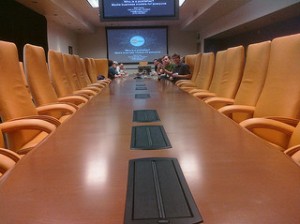I’m not a betting man .. I get far too emotionally involved in things to be able to be objective enough. For example: Oxford will *always* win the University Boat Race. Always. This is everything to do with me being brought up in Oxfordshire and nothing to do with anything else.
However, if I were a betting man I would put a small wager down that you’ve never heard of the Network for Sustainable Business (NSB). They’re a small Canadian non-profit which produces and promotes academic research for sustainable business, with a whole slew of PhD types producing content on topics as varied as supply chains, climate change, consumerism and organisational culture.
NSB recently produced a neat four page document entitled “10 things new sustainability managers need to know“. With a little bit of massage this can easily be morphed into “10 things a sustainability website should show”. After all, and in the interests of transparency, if a sustainability manager knows these things then surely the company should communicate them?
1) How does sustainability support the company?
One of my regular twitter correspondents has a permanent bee in her bonnet about how sustainability should be part of and aligned to a company’s overall business strategy. Many companies don’t get this and see it as a question of broadbrush resource usage, philanthropic giving or marketing in disguise.
Instead a company should be clear about how its sustainability efforts have paid off as investments which have supported the business’ aims and objectives over the long term.
2) How is sustainability part of the corporate culture?
Sustainability is not an add-on to business as usual … it is business as usual. That’s the aspiration in any case.
Today all employees are aware of the financial limitations a business operates within to some degree or another, whether it’s to do with their wages, a new bit of kit which is needed or the latest product or service to be developed. This awareness needs to be broadened to embrace all things sustainable.
So a company should show how it’s actively engaged with all its employees at all levels about how their actions on behalf of the business promote its overall sustainability.
3) How is the supply chain competing in sustainability?
One of the big principles which has come out of the sustainability agenda is that no business is an island and none has primacy over all others. This is the basic principle of environmental ecology and it’s good to see this aligning with business strategy on the more abstract level.
However it’s more than just getting yourself certified or using products and services from suppliers whose standards you approve of. This too has to be a question of communication, investment and collaboration … and it is these efforts which can be described on the website.
4) Do our consumers / clients pay for sustainable products?
The answer to this has to be “Yes”. If it’s not then sustainability isn’t supporting the company and there’s something going wrong with the upstream supply chain.
However once again this is the ideal situation. A business cannot convert all its products and services to being sustainable and then expect its client base to go “brilliant” and start buying them. There has to be communication there and perhaps a transition period.
So how is a company managing this? Which of its products or services are sustainable, and which are not, and what are its plans to transition? Furthermore, how is it measuring consumer engagement with sustainability and what efforts is it making to promote sustainability?
Here a very careful line needs to be drawn. There is nothing wrong with marketing sustainable products, so long as you don’t fall into the ninth circle of hell (treachery, or greenwashing as it’s more commonly called today). However that’s not what we’re talking about here. Instead, this is all about WHY sustainability is important, not what your business is providing to satisfy that need.
5) How do you engage your stakeholders?
Many of the points above are all about communicating and collaborating with certain groups of a business’ stakeholder community. However while employees, customers and suppliers are all stakeholders a company is most used to considering it comes into contact with many other groups of stakeholders.
There is a simple test about who a company’s stakeholders are: if the company is in contact with them, then they’re stakeholders.
The next most common stakeholder considered by businesses is the local community. Others include industry bodies, competitors and the regulatory authorities. What other ones are there and how are they being engaged as part of the company’s sustainability strategy? Each will be different so this is not going to be a simple task to document!
Picture Credit: Two hands by Brian Kelley under CC Attribution Share Alike license. Modified by Chris Milton.
Lucy is Editor at Corporate Eye



